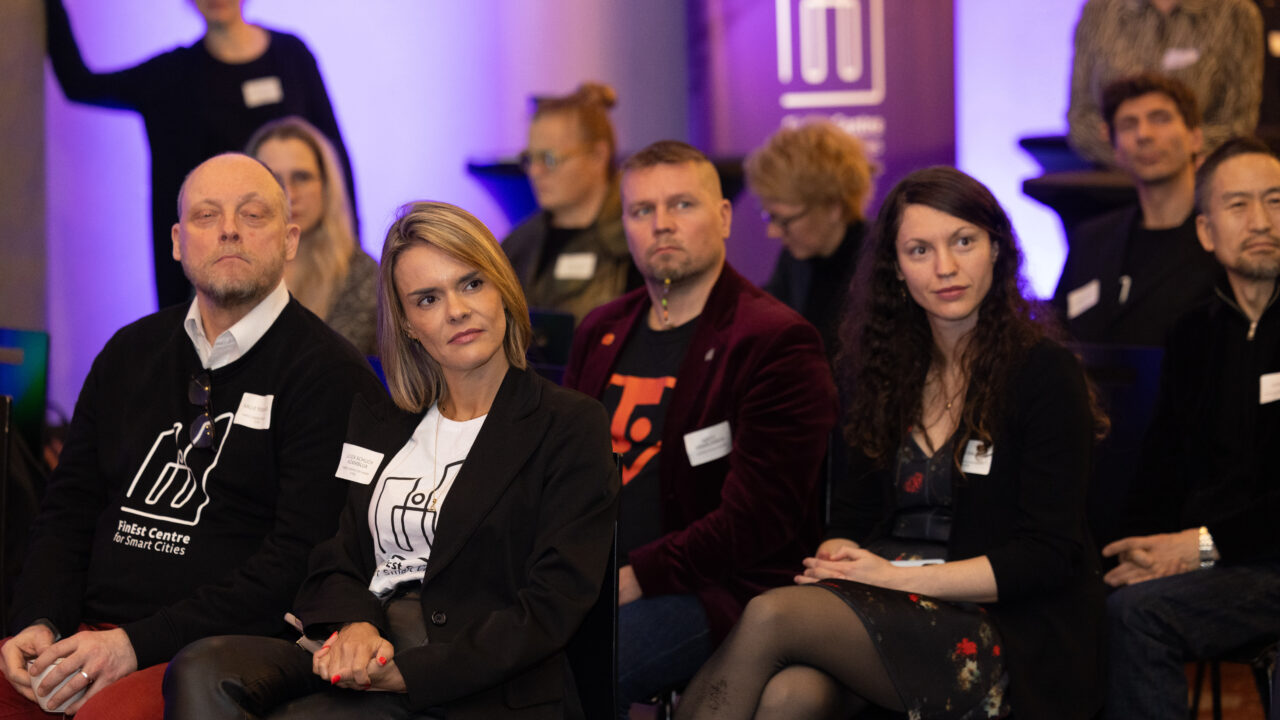On March 13, 2025, hundreds of city enthusiasts and experts gathered at the Proto Discovery Centre in Tallinn, under the leadership of the FinEst Smart City Excellence Centre. The building’s walls, rich with industrial heritage, served as a backdrop for a lively discussion that took place amidst old factory pipes and steam engines. Entrepreneurs, city leaders, officials, and researchers all united by a passion for urban renewal were present at the event.
Over steaming coffee cups, first impressions were exchanged on the latest achievements in artificial intelligence and data-driven urban governance possibilities. The English-language forum brought together representatives from both the public and private sectors to discuss how data, artificial intelligence, and smart governance could help create sustainable and human-centered urban spaces.
Smart cities need smartly led institutions
The forum was opened by Tallinn’s mayor, Jevgeni Ossinovski, who emphasized in his welcoming speech that Tallinn and other Estonian cities are standing on the threshold of a new type of challenge – urban development requires both innovation and collaboration. This idea set the stage for the main theme of the day – smart governance in a rapidly changing world.
In his presentation, Rainer Kattel – Professor of Innovation and Public Governance at University College London – painted a panoramic picture of how city governments could better prepare for the complex challenges of the 21st century. Kattel introduced a new global initiative: the Public Sector Dynamic Capabilities Index, which will be used for the first time to measure the ability of city governments to tackle complex problems.
The index focuses on citizen engagement in innovation, cross-sector collaboration, and the skilful use of data infrastructure. According to the professor, such a “mirror” will soon allow city leaders and funders to see which areas their city is strong in and where there is room for development.
Pärast Katteli sõnavõttu avas energiapoliitika professor Einari Kisel kuulajate kõrvad energiasektori muutuvatele väljakutsetele. Roheenergiale üleminek nõuab mitte ainult uut tehnoloogiat, vaid ka paindlikumat poliitikakujundamist, uutmoodi juhtimisstruktuure ning seadusandluse ümberhäälestamist.
Kisel viitas oma ettekandes, et kui valitsemine on puudulik, võib ka kõige innovaatilisem tehnoloogia linnaelanike jaoks kasutult seisma jääda – targad linnad vajavad targalt juhitud institutsioone.
Data helps improve mobility options in urban spaces
The idea that technology alone does not make a city smart led into the next focus topic of the forum – the question of how data related to urban mobility can be developed to foster collaboration in this area. Anniki Puura, a researcher at the Smart City Hub, discussed the success stories and challenges of smart mobility.
Puura shared examples of how cities, businesses, and citizens can find common goals and initiate partnerships by sharing urban mobility data. “Smart mobility is not just about technology – it’s about collaboration,” emphasized Puura, noting that it is the data that helps find common ground among different parties and improve urban mobility options together.
Whether it’s autonomous buses, bike lane networks, or parking apps, it all boils down to how we can get people and institutions to work together towards common goals. In this regard, it’s worth looking to the Nordic countries, where open data platforms have led to the creation of countless new mobility services. However, cooperation requires trust: sharing data between the city and businesses is not a given and requires a level playing field with clear rules.
Regulatory sandbox
Regulatory innovation might sound dry at first glance, but it became a key topic at the forum. During the morning panel discussion, the question was posed directly: can a “regulatory sandbox” and real life create a situation that satisfies all parties involved?
A regulatory sandbox is a legal framework that creates a controlled environment in which participating companies are temporarily exempt from adhering to the usual strict regulations. The goal is to give stakeholders the opportunity to “play” in the sandbox without regulatory constraints, allowing them to test innovative ideas and products and assess whether they could succeed in the market.
A series of experts took the stage to share their experiences with regulatory innovation and engage in a debate on the topic: Egert Juuse from TalTech provided an overview of how innovation-supporting regulations can be designed; the broader thematic discussion was moderated by experienced urban innovation consultant Jarmo Eskelinen; the discussion also included Greta Elva-Jõemaa, leader of the Accelerate Estonia innovation program, Helena Lepp, who designs public e-services at Digital Nation, and Tomaž Lanišek, a representative from the Slovenian city of Kranj, which has tested innovative solutions involving community engagement.
The discussion also had a skeptical tone: will solutions born in the “sandbox” ever make it to “real life,” or will they remain in the sandbox? How do you balance public interest with private sector ambitions? Of course, no consensus emerged in the hour-long discussion, but several panelists agreed that opposing innovation and regulation is misguided – they need to complement each other, and a favorable yet responsible legal framework is necessary for new developments.
The forum shared the view that Estonia, with its e-success story, is in a good position to experiment with flexible regulations – for example, a smaller city could serve as a “sandbox” for testing autonomous buses or implementing data-driven healthcare solutions. However, a warning was also voiced: poorly thought-out regulation could stifle even the best ideas.
Virtual city as a testing ground
In an intriguing panel discussion titled “How to govern a city version?” – the virtual city – two experts, public sector innovation expert Alessandro Paciaroni and TalTech big data sociologist Anu Masso, met to discuss virtual reality and urban governance. The conversation was framed around the word “citiverse,” which refers to the symbiosis of the city and the metaverse – an idea in which virtual worlds complement the physical urban environment. Paciaroni and Masso’s discussion unfolded in an informal manner, as though two like-minded individuals had gathered by the fireplace to set the world straight.
The conversation covered digital twins of cities, virtual reality in urban planning, and even the question of whether a virtual city needs its own “virtual mayor.” Although the topic was playful, serious and tangible challenges emerged: privacy, data security, and citizen involvement in these new environments. Masso warned that if virtual worlds are left unregulated, they could become environments resembling the “Wild West.”
Paciaroni, on the other hand, saw potential in citizen involvement: a virtual twin could serve as a testing ground where residents could safely try out new parks or redesigned public squares before they are actually built. The audience found this conversation both inspiring and thought-provoking – realizing that the concept of a smart city is soon to expand into entirely new dimensions, where the physical and digital spaces intertwine in previously unknown ways.
It’s important for cities to control their digital infrastructure
Before the ideas drifted into the clouds (or cloud spaces), the next speaker brought the discussion back to a specific and timely issue. Luukas Kristjan Ilves, an experienced e-governance strategist and advisor to the Ukrainian Minister of Digital Transformation, spoke about data sovereignty in turbulent times. Recent geopolitical tensions – whether cyberattacks or wars – have demonstrated how crucial it is for cities to control their critical data and digital infrastructure.
Ilves asked directly: are our cities prepared for a situation where, due to some external factor, cloud storage services are interrupted, or a large technology company unilaterally changes the rules? He stressed that cities need to agree on digital autonomy in the same way they do on energy security – they must create contingency plans, consider local data centers, and develop awareness regarding the final storage of data.
Ilves pointed out that while Europe’s strong data protection and regulatory framework is designed to protect citizens’ interests, excessive bureaucracy can also hinder innovation for local businesses. He proposed a concrete solution: Estonian cities could collectively ensure that critical city systems (such as traffic management or emergency services communications) are protected from both cyber threats and geopolitical risks, and, if necessary, create independent solutions.
Too strict regulations kill good ideas before they’re born
In the panel discussion “Regulation and Innovation – Friends or Foes?” representatives from the academic and practical worlds faced off. The moderator, Sille Sepp, head of data ecosystems at the Smart City Centre of Excellence, set the pace for the conversation by asking whether the new EU regulations on digital technology and artificial intelligence will hinder or promote smart urban development.
Silver Kelk, innovation manager at Ülemiste City, shared the business perspective: he stated that the private sector thirsts for clear yet flexible rules – overly strict regulations can kill a good idea before it even comes to life, while every serious solution needs a solid framework to enter the market.
Rainer Kattel, now in the role of panelist, provided the academic viewpoint: he acknowledged that Europe’s cautious regulatory culture has made the continent a champion of ethical standards, but this should not stifle technology.
Tallinn’s deputy mayor, Margot Roose, added practical examples from the city level: whether it’s drone flying in the city or sensor-equipped trash bins – cities often need to help legislation catch up. According to Roose, a city is like a living lab, where innovation happens before laws are established.
Stina Avvo, representing the legal department of the Ministry of Justice and Digital Affairs, defended the necessity of regulations: without clear rules, citizens’ trust in new technologies may diminish.
Inevitably, the discussion turned to the EU’s AI regulations and data rules – with a consensus emerging that Estonia’s voice should be clear in these debates, advocating for proportionality. The panel concluded with cautious optimism: when designed properly, regulations can be allies of innovation, not foes.
A smart city can balance algorithms and the human soul
At the end of the day, when minds were already full of ideas, another inspiring perspective was shared – this time through the eyes of an entrepreneur. Mari-Liis Kell, leader of green innovation, spoke specifically about the Hundipea development – a new waterfront district in Tallinn that is planned to be built based on entirely new principles. Kell described how scientific and data-driven approaches are woven into the planning of the area. In the Hundipea development, biodiversity data is considered in the planning of parks, and climate simulations are used in the design of buildings.
Kell’s key words – people and nature – gave a heartfelt conclusion to a technology-filled day. After all, a smart city, in the end, is one that can maintain a balance between innovation and quality of life, concrete and greenery, algorithms and the human soul.
FinEst Targa Linna Tippkeskuse direktor Ralf-Martin Soe juhtis lõpusõnades tähelepanu, et foorum toimub küll üks kord aastas, ent tarku linnu arendatakse iga päev – see on lakkamatu koostöö, katsetamise ja õppimise protsess. Soe julgustas kõiki kohalolijaid viima saadud ideid oma linnadesse laiali ning püsima ühenduses, sest edasi viib just kogukondlik teadmiste jagamine.




